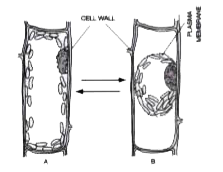A human RBC is placed in 1.5% salt solution . It will :-
swell up
shrink
remain unaffected
burst
The correct Answer is:B
For human RBC , 0.9% salt solution is isotonic . Hence a medium of 1.5% salt solution would be hypertonic i.e. more concentrated. Hence the RBC will shrink due to exosmosis.
Similar Questions
Knowledge Check
- Question 1 - Select One
When a cell is placed in 0.5 M solution of salt and no change in the volume of the cell is observed, the concentration of cell sap would be
A0.5 MB0.05 MC5.0 MD50 M - Question 2 - Select One
A cell placed in a hypertonic salt solution will shrink because
Awater will move from the salt solution to the cell sapBwater will move from the cell sap to the salt solutionCcytoplasm decomposesDmineral salts break the cell wall - Question 3 - Select One
An unriped mango placed in a concentrated salt solution to prepare pickle shrivels because……
Ait gains water due to osmosisBit loses water due to reverse osmosisCit gain water due to reverse osmosisDit loses water due to osmosis
An unpire mango placed in a concentrated salt solution to prepare pickle shrivels because……
View SolutionA cell placed in 0.5 M sugar solution was found to be with no change in cell volume. If the same cell is placed in 0.5 M of sodium chloride solution , then there will be
View SolutionIf silver nitrate solution is added to a salt solution and a yellow precipitate is obtained the salt may contain
View SolutionRBC placed in distilled water will
View SolutionGiven below are diagrams of plant cells as seen under the microscope after being placed in two different solutions :

From the solutions given in brackets (water, strong sugar solution , 1% salt solution) name the solution into which :
(1) Cell A (2) Cell B was placed before being viewed under the microscope.View Solution
